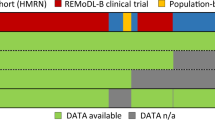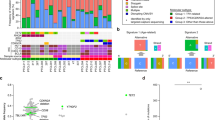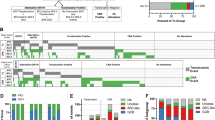Abstract
Anaplastic large cell lymphoma (ALCL) is a main type of T-cell lymphomas and comprises three distinct entities: systemic anaplastic lymphoma kinase (ALK) positive, systemic ALK− and cutaneous ALK− ALCL (cALCL). Little is known about their pathogenesis and their cellular origin, and morphological and immunophenotypical overlap exists between ALK− ALCL and classical Hodgkin lymphoma (cHL). We conducted gene expression profiling of microdissected lymphoma cells of five ALK+ and four ALK− systemic ALCL, seven cALCL and sixteen cHL, and of eight subsets of normal T and NK cells. The analysis supports a derivation of ALCL from activated T cells, but the lymphoma cells acquired a gene expression pattern hampering an assignment to a CD4+, CD8+ or CD30+ T-cell origin. Indeed, ALCL display a down-modulation of many T-cell characteristic molecules. All ALCL types show significant expression of NFκB target genes and upregulation of genes involved in oncogenesis (e.g. EZH2). Surprisingly, few genes are differentially expressed between systemic and cALCL despite their different clinical behaviour, and between ALK− ALCL and cHL despite their different cellular origin. ALK+ ALCL are characterized by expression of genes regulated by pathways constitutively activated by ALK. This study provides multiple novel insights into the molecular biology and pathogenesis of ALCL.
This is a preview of subscription content, access via your institution
Access options
Subscribe to this journal
Receive 12 print issues and online access
$259.00 per year
only $21.58 per issue
Buy this article
- Purchase on Springer Link
- Instant access to full article PDF
Prices may be subject to local taxes which are calculated during checkout




Similar content being viewed by others
Accession codes
References
Swerdlow SH, Campo E, Harris NL, Jaffe ES, Pileri SA, Stein H et al., editors WHO classification of tumours of haematopoietic and lymphoid tissues. 4nd edn IARC Press: Lyon, 2008.
Stein H, Mason DY, Gerdes J, O’Connor N, Wainscoat J, Pallesen G et al. The expression of the Hodgkin's disease associated antigen Ki-1 in reactive and neoplastic lymphoid tissue: evidence that Reed-Sternberg cells and histiocytic malignancies are derived from activated lymphoid cells. Blood 1985; 66: 848–858.
Amin HM, Lai R . Pathobiology of ALK+ anaplastic large-cell lymphoma. Blood 2007; 110: 2259–2267.
Kutok JL, Aster JC . Molecular biology of anaplastic lymphoma kinase-positive anaplastic large-cell lymphoma. J Clin Oncol 2002; 20: 3691–3702.
ten Berge RL, Oudejans JJ, Ossenkoppele GJ, Meijer CJ . ALK-negative systemic anaplastic large cell lymphoma: differential diagnostic and prognostic aspects—a review. J Pathol 2003; 200: 4–15.
Liu HL, Hoppe RT, Kohler S, Harvell JD, Reddy S, Kim YH . CD30+ cutaneous lymphoproliferative disorders: the Stanford experience in lymphomatoid papulosis and primary cutaneous anaplastic large cell lymphoma. J Am Acad Dermatol 2003; 49: 1049–1058.
Stein H, Foss HD, Durkop H, Marafioti T, Delsol G, Pulford K et al. CD30(+) anaplastic large cell lymphoma: a review of its histopathologic, genetic, and clinical features. Blood 2000; 96: 3681–3695.
Bonzheim I, Geissinger E, Roth S, Zettl A, Marx A, Rosenwald A et al. Anaplastic large cell lymphomas lack the expression of T-cell receptor molecules or molecules of proximal T-cell receptor signaling. Blood 2004; 104: 3358–3360.
Foss HD, Anagnostopoulos I, Araujo I, Assaf C, Demel G, Kummer JA et al. Anaplastic large-cell lymphomas of T-cell and null-cell phenotype express cytotoxic molecules. Blood 1996; 88: 4005–4011.
Krenacs L, Wellmann A, Sorbara L, Himmelmann AW, Bagdi E, Jaffe ES et al. Cytotoxic cell antigen expression in anaplastic large cell lymphomas of T- and null-cell type and Hodgkin′s disease: evidence for distinct cellular origin. Blood 1997; 89: 980–989.
Medeiros LJ, Elenitoba-Johnson KS . Anaplastic large cell lymphoma. Am J Clin Pathol 2007; 127: 707–722.
Jaffe ES . Anaplastic large cell lymphoma: the shifting sands of diagnostic hematopathology. Mod Pathol 2001; 14: 219–228.
Bräuninger A, Schmitz R, Bechtel D, Renne C, Hansmann ML, Kuppers R . Molecular biology of Hodgkin′s and Reed/Sternberg cells in Hodgkin′s lymphoma. Int J Cancer 2006; 118: 1853–1861.
Schwering I, Bräuninger A, Klein U, Jungnickel B, Tinguely M, Diehl V et al. Loss of the B-lineage-specific gene expression program in Hodgkin and Reed-Sternberg cells of Hodgkin lymphoma. Blood 2003; 101: 1505–1512.
Brune V, Tiacci E, Pfeil I, Döring C, Eckerle S, van Noesel C et al. Origin and pathogenesis of nodular lymphocyte-predominant Hodgkin lymphoma as revealed by global gene expression analysis. J Exp Med 2008; 205: 2251–2268.
Küppers R . Mechanisms of B-cell lymphoma pathogenesis. Nat Rev Cancer 2005; 5: 251–262.
Baldwin AS . Control of oncogenesis and cancer therapy resistance by the transcription factor NF-kappaB. J Clin Invest 2001; 107: 241–246.
Bargou RC, Leng C, Krappmann D, Emmerich F, Mapara MY, Bommert K et al. High-level nuclear NF-kappa B and Oct-2 is a common feature of cultured Hodgkin/Reed-Sternberg cells. Blood 1996; 87: 4340–4347.
Martinez-Delgado B, Cuadros M, Honrado E, Ruiz de la Parte A, Roncador G, Alves J et al. Differential expression of NF-kappaB pathway genes among peripheral T-cell lymphomas. Leukemia 2005; 19: 2254–2263.
Lamant L, de Reynies A, Duplantier MM, Rickman DS, Sabourdy F, Giuriato S et al. Gene-expression profiling of systemic anaplastic large-cell lymphoma reveals differences based on ALK status and two distinct morphologic ALK+ subtypes. Blood 2007; 109: 2156–2164.
Thompson MA, Stumph J, Henrickson SE, Rosenwald A, Wang Q, Olson S et al. Differential gene expression in anaplastic lymphoma kinase-positive and anaplastic lymphoma kinase-negative anaplastic large cell lymphomas. Hum Pathol 2005; 36: 494–504.
Cho-Vega JH, Rassidakis GZ, Amin HM, Tsioli P, Spurgers K, Remache YK et al. Suppressor of cytokine signaling 3 expression in anaplastic large cell lymphoma. Leukemia 2004; 18: 1872–1878.
Janik JE, Morris JC, Pittaluga S, McDonald K, Raffeld M, Jaffe ES et al. Elevated serum-soluble interleukin-2 receptor levels in patients with anaplastic large cell lymphoma. Blood 2004; 104: 3355–3357.
Tamaru J, Tokuhira M, Nittsu N, Nakamura S, Ichinohasama R, Suzuki R et al. Hodgkin-like anaplastic large cell lymphoma (previously designated in the REAL classification) has same immunophenotypic features to classical Hodgkin lymphoma. Leuk Lymphoma 2007; 48: 1127–1138.
Rust R, Visser L, van der Leij J, Harms G, Blokzijl T, Deloulme JC et al. High expression of calcium-binding proteins, S100A10, S100A11 and CALM2 in anaplastic large cell lymphoma. Br J Haematol 2005; 131: 596–608.
Thorns C, Gaiser T, Lange K, Merz H, Feller AC . cDNA arrays: gene expression profiles of Hodgkin′s disease and anaplastic large cell lymphoma cell lines. Pathol Int 2002; 52: 578–585.
Trempat P, Villalva C, Xerri L, Armstrong F, Duplantier MM, Delsol G et al. Gene expression profiling in anaplastic large cell lymphoma and Hodgkin′s disease. Leuk Lymphoma 2004; 45: 2001–2006.
Villalva C, Trempat P, Greenland C, Thomas C, Girard JP, Moebius F et al. Isolation of differentially expressed genes in NPM-ALK-positive anaplastic large cell lymphoma. Br J Haematol 2002; 118: 791–798.
Wellmann A, Thieblemont C, Pittaluga S, Sakai A, Jaffe ES, Siebert P et al. Detection of differentially expressed genes in lymphomas using cDNA arrays: identification of clusterin as a new diagnostic marker for anaplastic large-cell lymphomas. Blood 2000; 96: 398–404.
Willenbrock K, Küppers R, Renne C, Brune V, Eckerle S, Weidmann E et al. Common features and differences in the transcriptome of large cell anaplastic lymphoma and classical Hodgkin′s lymphoma. Haematologica 2006; 91: 596–604.
de Leval L, Rickman DS, Thielen C, Reynies A, Huang YL, Delsol G et al. The gene expression profile of nodal peripheral T-cell lymphoma demonstrates a molecular link between angioimmunoblastic T-cell lymphoma (AITL) and follicular helper T (TFH) cells. Blood 2007; 109: 4952–4963.
Dittmer J . The biology of the Ets1 proto-oncogene. Mol Cancer 2003; 2: 29.
Ji HB, Gupta A, Okamoto S, Blum MD, Tan L, Goldring MB et al. T cell-specific expression of the murine CD3delta promoter. J Biol Chem 2002; 277: 47898–47906.
Kuo CT, Leiden JM . Transcriptional regulation of T lymphocyte development and function. Annu Rev Immunol 1999; 17: 149–187.
Salmon P, Giovane A, Wasylyk B, Klatzmann D . Characterization of the human CD4 gene promoter: transcription from the CD4 gene core promoter is tissue-specific and is activated by Ets proteins. Proc Natl Acad Sci USA 1993; 90: 7739–7743.
Mathas S, Johrens K, Joos S, Lietz A, Hummel F, Janz M et al. Elevated NF-kappaB p50 complex formation and Bcl-3 expression in classical Hodgkin, anaplastic large-cell, and other peripheral T-cell lymphomas. Blood 2005; 106: 4287–4293.
Iacobelli M, Wachsman W, McGuire KL . Repression of IL-2 promoter activity by the novel basic leucine zipper p21SNFT protein. J Immunol 2000; 165: 860–868.
Jiang W, Xiang C, Cazacu S, Brodie C, Mikkelsen T . Insulin-like growth factor binding protein 7 mediates glioma cell growth and migration. Neoplasia 2008; 10: 1335–1342.
Sparmann A, van Lohuizen M . Polycomb silencers control cell fate, development and cancer. Nat Rev Cancer 2006; 6: 846–856.
Raaphorst FM, Otte AP, van Kemenade FJ, Blokzijl T, Fieret E, Hamer KM et al. Distinct BMI-1 and EZH2 expression patterns in thymocytes and mature T cells suggest a role for polycomb genes in human T cell differentiation. J Immunol 2001; 166: 5925–5934.
Tonini T, D’Andrilli G, Fucito A, Gaspa L, Bagella L . Importance of Ezh2 polycomb protein in tumorigenesis process interfering with the pathway of growth suppressive key elements. J Cell Physiol 2008; 214: 295–300.
Gjerdrum LM, Woetmann A, Odum N, Hother C, Henrik-Nielsen R, Gniadecki R et al. FOXP3 positive regulatory T-cells in cutaneous and systemic CD30 positive T-cell lymphoproliferations. Eur J Haematol 2008; 80: 483–489.
Hinz M, Lemke P, Anagnostopoulos I, Hacker C, Krappmann D, Mathas S et al. Nuclear factor kappaB-dependent gene expression profiling of Hodgkin′s disease tumor cells, pathogenetic significance, and link to constitutive signal transducer and activator of transcription 5a activity. J Exp Med 2002; 196: 605–617.
Acknowledgements
We highly appreciate the excellent technical assistance of Ralf Lieberz, Nicole Dieckert, Yvonne Michel, Ingrid Kremser and Klaus Lennartz. We thank Dr Detlef Güssow and Melanie Kühnl from Merck KGaA, Darmstadt, Germany for the opportunity to scan the Affymetrix arrays in their laboratory. This work was supported by grants from the Deutsche Forschungsgemeinschaft (KU1315/5-2, BR1238/6-2 and 6-3 and WI2015/1-1), the Deutsche Krebshilfe and the Associazione Italiana per la Ricerca sul Cancro (AIRC). Enrico Tiacci was recipient of a fellowship (F 05/01) granted by the German José Carreras Leukemia Foundation.
Author information
Authors and Affiliations
Corresponding author
Additional information
Supplementary Information accompanies the paper on the Leukemia website (http://www.nature.com/leu)
Rights and permissions
About this article
Cite this article
Eckerle, S., Brune, V., Döring, C. et al. Gene expression profiling of isolated tumour cells from anaplastic large cell lymphomas: insights into its cellular origin, pathogenesis and relation to Hodgkin lymphoma. Leukemia 23, 2129–2138 (2009). https://doi.org/10.1038/leu.2009.161
Received:
Revised:
Accepted:
Published:
Issue Date:
DOI: https://doi.org/10.1038/leu.2009.161



